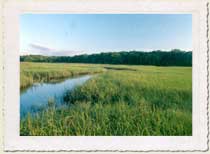
Lemon Creek Park Preserve
Borough: Staten Island
Acres: 16
Habitat Type: Salt Marsh, Freshwater Wetland, Forest
Map: PDF
Lemon Creek Preserve contains the largest and most pristine salt marsh on Staten Island’s south shore. The marsh is contiguous with a larger expanse of state-owned marsh north of Hylan Boulevard. Steep forested slopes rise on either side of the marsh. The forest protects the marsh by preventing erosion and sediment deposition from the slopes into the marsh. A freshwater pond, only 100 feet from Raritan Bay, is adjacent to the only purple martin (Progne subis) colony in New York City. These gregarious birds nest in apartment-house-style structures maintained by volunteers.
Lemon Creek is fed from a watershed that begins two-and-one-half miles from the creek. The main source is a small freshwater pond near Woodrow Road, known as Porzio’s Pond. The water travels over and under ground to Lemon Creek, which carries it down to Prince’s Bay, and ultimately to Raritan Bay. The red clay bluffs in the park, reaching 85 feet above Prince’s Bay at Mt. Loretto, are part of the harbor hill terminal moraine (a ridge or landform marking the farthest advance of a glacier or ice sheet). A glacier that receded approximately 15,000 years ago created these bluffs, which are the tallest ocean-facing cliffs in New York State.
Lemon Creek Park’s waterfront area provides a spawning ground for many species of fish and shellfish. Although clamming is now prohibited for pollution reasons, the Lemon Creek fishing pier, at the foot of Sharrott Avenue, offers the opportunity to cast a line and catch flounder, striped bass, bluefish, weakfish, and others. Every May and June, horseshoe crabs (Limulus polyphemus) emerge from the Raritan Bay onto the beaches in Lemon Creek Park. Female horseshoe crabs arrive on the beaches to lay their eggs, with their male counterparts literally in tow. Males grasp onto the back of the female’s shell using their specially adapted, hooked legs, sometimes two, three, or four males onto one female. When they arrive on the beach, female horseshoe crabs dig a hole in the sand and lay up to 20,000 tiny olive-green eggs inside. The males then rush to be the first to fertilize.
Directions
Public Transit: From the Staten Island Ferry, take the Staten Island Railroad from the St. George terminal and get off at the Princess Bay stop. The S53 (weekdays only) travels south on Seguine Ave to Hylan Blvd. Walk south along Seguine Ave and the entrance to the park is at the end of Seguine Ave on the right. The S78 and S59 buses run along Hylan Blvd and intersect with Seguine Ave.
By Car: Hylan Blvd is accessible from the Staten Island Expressway (278) from Brooklyn. Take the first exit off 278 for Narrows Road North and then make a left on Hylan Blvd. Hylan Blvd runs the length of Staten Island’s southeast side. After about 12 miles, make a left on Seguine Ave and the preserve entrance is at the end on the right.
Or
From 440 (Outerbridge crossing) and West Shore Expressway, merge onto the Korean Veterans War Memorial Parkway and take the first exit onto the South Service Road of 440. Make a right on Foster Road which turns into Seguine Ave. The preserve entrance is at the end of the road on the right.
